This sample Understanding Homicide and Aggravated Assault Research Paper is published for educational and informational purposes only. If you need help writing your assignment, please use our research paper writing service and buy a paper on any topic at affordable price. Also check our tips on how to write a research paper, see the lists of criminal justice research paper topics, and browse research paper examples.
This research paper considers the cultural meanings, empirical patterns, theoretical explanations, and social responses connected with homicide and aggravated assault. The paper addresses:
- Homicide and aggravated assault trends in the United States over the past several decades
- Cross-national comparisons of homicide and assault
- Characteristics of victims, perpetrators, and incidents
- The relationship between victims and perpetrators
- Theories of violence
- Policies to reduce violent crime
The main empirical patterns in homicide and serious assault are easily summarized, less easily explained. Rates of homicide and aggravated assault have exhibited substantial volatility in the United States, rising to peak levels by the early 1990s and then falling over the next decade to 30-year lows. Cross-national comparisons reveal strikingly higher rates of homicide, but not assault, in the United States than other developed nations. In all nations where they have been recorded, rates of homicide and serious assault are higher among men and the young than women and older persons. In the United States, the prevalence of homicide and serious assault is greater among African-Americans and Hispanics than non-Hispanic whites. In all groups, firearm use greatly increases the risk that a violent encounter results in the victim’s death. Large fractions of victims are acquainted with the perpetrator in homicide and aggravated assault, sometimes intimately. Women are more likely than men to be killed or injured in attacks by an intimate partner. Rates of intimate partner violence have fallen in recent years, but the decrease differs by sex and lethality. Greater reductions in assault victimization have occurred among women than men, and homicide victimization has decreased more among men than women.
Although homicide and serious assault have declined in the United States, the reasons why remain something of a mystery. Mass imprisonment is one contributor to the crime decline, but its other social consequences are troubling, and even its crime-reduction benefits may dissipate over time. The same sense of political purpose, widespread mobilization, and forceful leadership that ushered in the era of mass imprisonment will be required to bring about needed reforms under the banner of “prisoner reentry,” the reintegration of released prisoners into the social and political mainstream. A surprising degree of political support for prisoner reentry currently exists, but that is likely to last only until violent crime rates begin to rise again.
Introduction
Homicide and aggravated assault are forms of violent crime. A “crime” is a violation of criminal law, but what is “violence”? That turns out to be a difficult question. Should the definition of violence be limited to acts causing physical harm? What about threats of harm? Can mere words or symbols constitute violence? Is defacing religious property or burning a cross on someone’s lawn a violent act?
Social scientists do not agree on a single or unified definition of violence. Psychologists generally prefer broad definitions that include behaviors producing emotional harm. The Committee on Family Violence of the National Institute of Mental Health, for example, offers a definition that not only includes acts threatening or inflicting physical harm but those resulting in “restraint of normal activities or freedom, and denial of access to resources” (quoted in Crowell and Burgess 1996, p. 10). By this definition, prisons and poverty could be considered forms of violence.
Criminologists tend to favor narrower definitions of violence focusing on physical harm or threats. Many, but not all, criminologists accept the definition provided by an influential National Research Council study of violence as “behaviors by individuals that intentionally threaten, attempt, or inflict physical harm on others” (Reiss and Roth 1993, p. 2). This definition includes a diverse assortment of behaviors, including homicide, assault, rape, torture, capital punishment, and boxing. But it excludes many acts that are encompassed by other, equally reasonable, definitions. How one chooses to define violence, as we shall see, prefigures the types of behavior that are counted as violence, the levels of violence observed across place and time, the theories that “make sense” of violent behavior, and the social response to violence.
Regardless of the definition, not all violence is criminal violence. Violence is made a crime through the criminalization process, which entails the selective application of the criminal law to violent acts. Criminal law, and law itself, are not universal. They have not always existed, and they do not impose uniform standards or sanctions on behavior, across societies or in the same society over time. It is a criminological truism that acts legally prohibited at one time or place may not be at others. A common example is prohibition of the manufacture, sale, and distribution of alcohol in the United States during the 1920s. But this maxim applies to violent behavior and not just so-called victimless crimes. Until late in the twentieth century in most US states, for example, a man could not be criminally charged with raping his wife; now all states have laws against marital rape (see Russell 1990).
Patterns Of Criminal Homicide And Assault
The foregoing discussion implies that how one chooses to define violence and the cultural meanings attached to particular instances of violent behavior will affect how violence is measured, the levels of violence observed across places at any given time, and trends in violence over time. What is true for violent behavior generally is also true for homicide and aggravated assault. Homicide is the willful killing of one human being by another. Some homicides are lawful, such as those committed in warfare or as legal punishment for crime, and some are criminal. Aggravated assault is an attack by one or more persons on another with the purpose of inflicting serious bodily injury, including threats and attempts, or an assault committed with a dangerous weapon – an “aggravating” condition (Federal Bureau of Investigation 2006). As with homicide, the behavior itself does not distinguish a criminal from noncriminal assault. The sport of boxing is a legally regulated form of assault.
In the United States, three sources of data can be used to track levels and trends in criminal homicide and assault: the FBI’s Uniform Crime Reports (UCR), the Bureau of Justice Statistics’ National Crime Victimization Survey (NCVS), and the National Center for Injury Prevention and Control’s (NCIPC) mortality and intentional injury data series. The UCR data are based on offenses reported to and recorded by police departments. The NCVS data are from representative surveys of the population age 12 and over. The NCIPC data are from hospital and death records. The three data sources complement one another in several ways. For example, the NCVS picks up crimes that are not reported to the police, and the UCR and NCIPC count homicides, which are not included in victim surveys. The NCIPC mortality series includes the nearly 3,000 homicides resulting from the 2001 terrorist attacks, whereas the FBI omitted these victims from its 2001 homicide statistics. Finally, the three series categorize rapes and other sexual assaults separately from other assaults.
Recent Trends In The United States
Criminal homicide and aggravated assault rates have exhibited marked fluctuation over the past several decades in the United States. UCR homicide rates between 1960 and 2005 are displayed in Fig. 1. Homicide rates were relatively stationary at 4–5 homicides per 100,000 population during the 1950s and early 1960s and then rose substantially over the next several years, peaking at just over 10 per 100,000 in 1980. They cycled between 8 and 10 per 100,000 until the early 1990s when they began a nearly decadelong drop, what one analyst has called the “Great American Crime Decline” (Zimring 2007). By 2000, US homicide rates had returned to levels not seen since the mid-1960s.
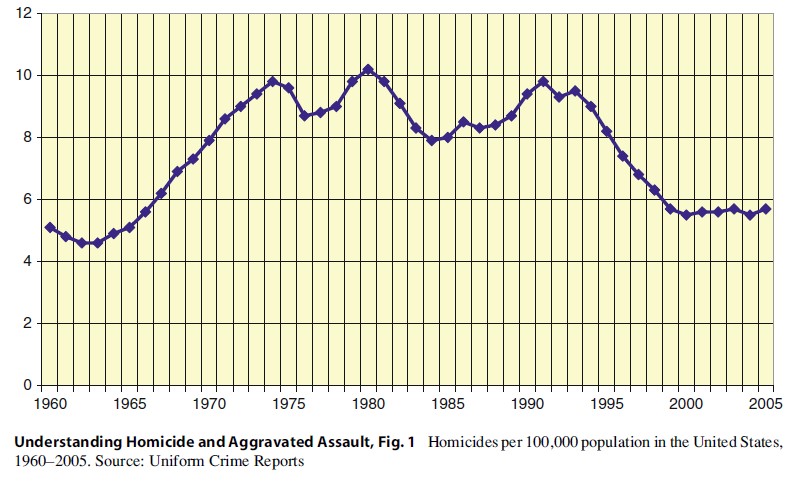
Aggravated assaults are measured in both the UCR and the NCVS, using virtually identical definitions. But the two series show very different patterns of change since 1973, the first year of the NCVS (see Fig. 2). Although both UCR and NCVS aggravated assault rates have fallen since the mid-1990s, the UCR series rose almost continuously before then, while the NCVS series decreased from 1973 until the early 1990s, increased for a few years, and then began to fall again.
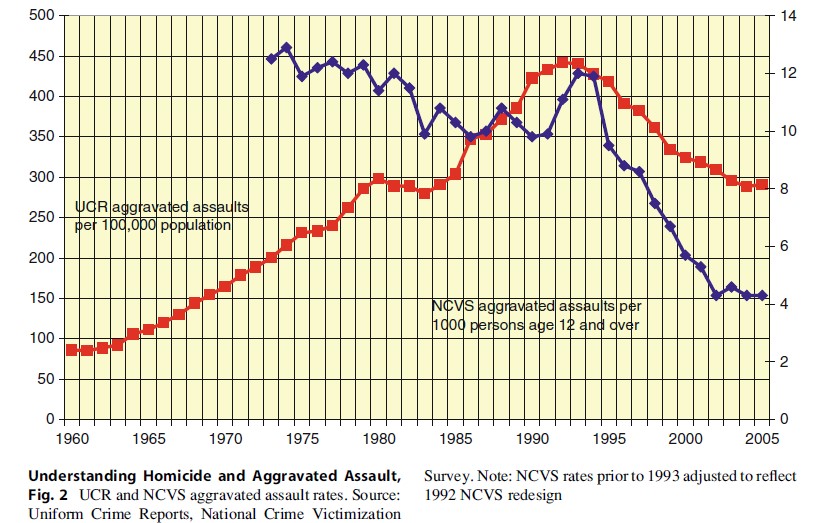
Some of the divergence between the two series could reflect a growing willingness by victims to report crimes to the police. All of the increase in reporting to the police, however, occurred well after the NCVS and UCR aggravated assault trends began to converge in the 1990s and, therefore, cannot explain the divergent trends of the earlier years (see Catalano 2006a).
The contrasting trends prior to the 1990s more likely reflect better police recording of crimes with the advent of computerized records and 911 emergency call systems, and police “upgrading” of many assaults as aggravated that in the past had been considered less serious crimes. The latter interpretation is supported by evidence showing much stronger correspondence between the UCR and NCVS time trends for assaults committed with firearms than those without a firearm. The police are unlikely to record firearm incidents as simple assaults, whereas they have much greater discretion in classifying incidents without firearms or very serious injury. Beginning in the 1970s, the women’s movement and domestic violence advocates began to press police and prosecutors to treat assaults more seriously, especially those with female victims, and those pressures contributed to the increase in aggravated assaults reflected in the UCR data series. Because the NCVS is based on standardized screening questions to determine criminal victimization and lacks the police recording “filter” of the UCR, the NCVS aggravated assault series is much less likely to be affected by such changes (see Rosenfeld 2007).
Changes in police recording of assaults provide an excellent illustration of how the cultural meanings of violence are redefined by social movements and affect the definition and measurement of violent crime. Assaults that the police, reflecting commonly held views, once had classified as misdemeanor offenses, or may not have recorded as crimes at all, were upgraded in seriousness with the increasing social status of victims. The rights and prerogatives of crime victims have grown during the past 30 years, with victims of so-called domestic violence leading the way. Mandatory and pro-arrest policies have reversed the legal protection once granted to violence occurring in the home. But, as we shall see, the effects of such policies on the incidence of domestic violence are more difficult to discern.
Cross-National Comparisons
Comparative assessments of changes in homicide or other crime rates over time are important because they can reveal limitations in explanations of crime trends that are restricted to a single nation, as is true of several leading explanations of the recent violent crime decline in the United States (Zimring 2007). Like those in the United States, the homicide rates of many developed nations rose during the 1970s and 1980s and have fallen since then, but there are plenty of exceptions. As an illustration, Figure 3 displays the homicide rates for Japan, Canada, and the United States between 1960 and 2000. Japan’s homicide rate dropped steadily over the 40-year period. By contrast, the Canadian trend mirrors the increases and declines in the United States, as shown by the best-fitting curves superimposed on the two nations’ homicide time series. Explanations of recent US crime trends that emphasize the importance of prison expansion and urban crack markets leave open the question of why Canada should have experienced much the same trends, without comparable changes in imprisonment or drug markets (Zimring 2007).
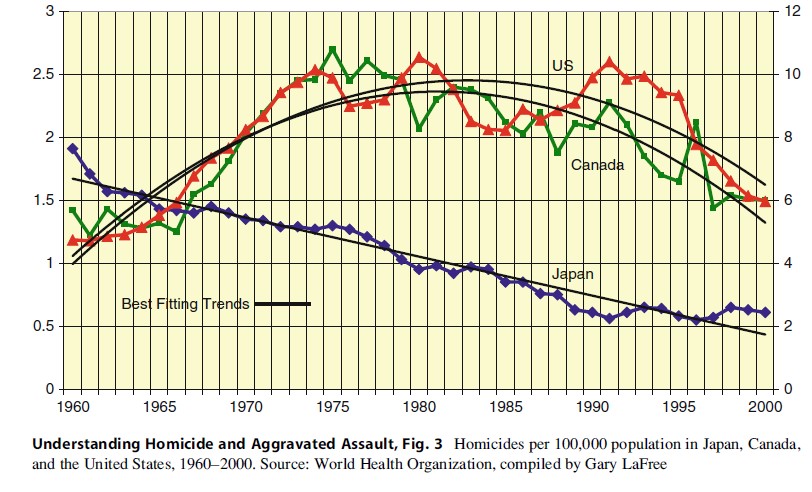
Explanations of cross-national differences in homicide also must contend with the substantial difference in homicide levels between the United States and other developed nations, regardless of the time period. Even after dropping by 40 % during the 1990s, the US homicide rate greatly exceeds those of other developed nations. Figure 4 displays the homicide rates of 14 highly industrialized, democratic nations in 2000. With six homicides per 100,000 population, the United States is the clear outlier in the group. The US homicide rate is three times those of Australia and Canada, its nearest competitors, and over six times the average rate of the remaining 11 nations.
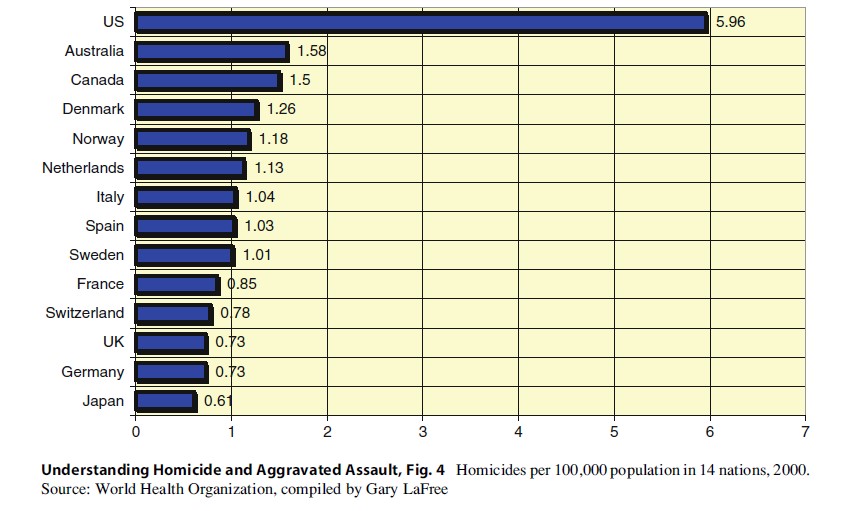
Some analysts attribute the large difference in homicide rates between the United States and other developed nations to the widespread availability of firearms in the United States (Zimring and Hawkins 1997). Others point to the fact that the rate of homicides committed without guns is also greater in the United States than other developed nations and call attention to a history of racial oppression, economic inequality, and lack of protection from market forces, in addition to the availability of guns, as reasons for the exceptionally high levels of criminal violence in the United States (Beeghley 2003; Messner and Rosenfeld 2007).
But are rates of “criminal violence” greater in the United States than other developed nations, or is American exceptionalism limited to homicide, as Zimring and Hawkins (1997) maintain? The prevalence of nonlethal assault does not appear to be greater in the United States than other developed countries. Figure 5 displays the percentage of respondents to the International Crime Survey (ICS) in 10 nations who reported that they were victims of one or more assaults in 1999. The United States is far from the top of the list, ranking just below Denmark and Sweden and well below Australia and the United Kingdom. This finding favors causal accounts able to explain why the United States dominates international comparisons of homicide but not other forms of criminal violence.
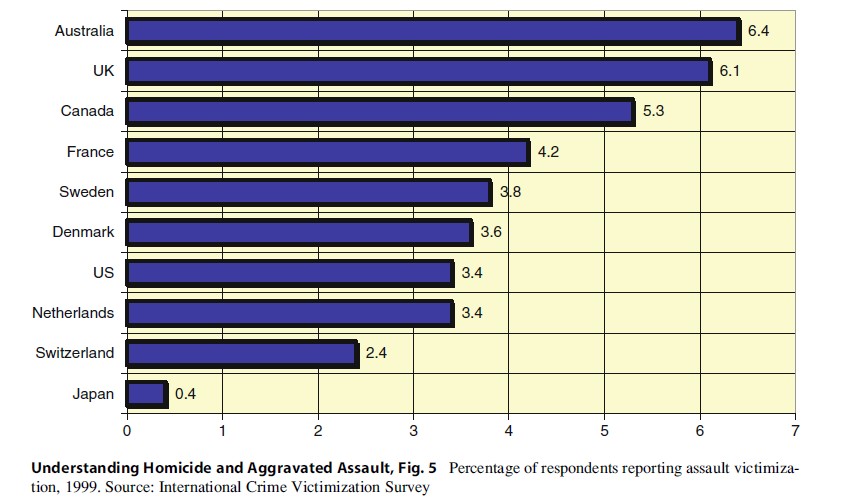
Characteristics Of Victims And Firearm Use
Nearly everywhere they have been assessed, rates of aggravated assault and homicide are higher among males and the young than females and older persons. In the United States, serious interpersonal violence is also more common among blacks and Hispanics than non-Hispanic whites. Table 1 presents 3-year average rates of aggravated assault and homicide in the USA by sex, race, ethnicity (Hispanic and Non-Hispanic), and age. The data represent rates of victimization; offending rates exhibit the same demographic patterns, except that offenders tend to be a few years younger than their victims.
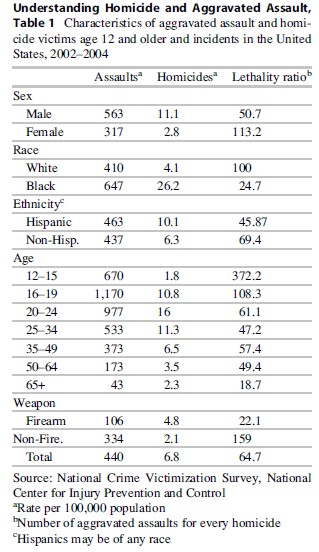
Looking first at rates of aggravated assault, we see that they are 78 % greater among males and 58 % greater among blacks than females and whites, respectively. Aggravated assault is somewhat more common among Hispanics than non-Hispanics, but this difference is smaller than the sex and race differences. Age-specific rates of aggravated assault exhibit a distinctive, curvilinear pattern, rising from early to late adolescence and falling steadily thereafter. With a victimization rate only one-tenth of the average rate of 440 per 100,000, persons over the age of 65 are particularly unlikely to be victims of serious assault. This “age-crime curve” characterizes many common criminal offenses.
Firearms are used in about one-quarter of aggravated assaults victims report to the NCVS. Recall that use of a dangerous weapon is one of the “aggravating” conditions that distinguish aggravated from simple assaults. The other condition is serious bodily injury. It turns out that aggravated assaults involving firearms are much less likely to produce injury than those committed with other weapons or none at all. But, if the presence of a firearm reduces the chance of nonfatal injury, it increases the chance that the victim will be killed, thereby converting an aggravated assault into a homicide (Kleck and McElrath 1991).
The homicide rate for persons 12 and older in the United States is 6.8 per 100,000, meaning that the average American over the age of 11 has a one-in-14,706 chance of becoming a homicide victim. The sex, race, ethnic, and age patterns in homicide are roughly similar to those in aggravated assault, although the group differences are larger. Males are about four times more likely than females to be the victim of a homicide. The homicide rate among blacks is more than six times that among whites, and the risk of homicide is about 60 % higher among Hispanics than others. Like aggravated assaults, homicide rates rise during adolescence, but peak a few years later in the early 20s before falling through the remainder of the life course, as shown in Fig. 6. Finally, in contrast to aggravated assault, about two-thirds of homicides are committed with a firearm, so that the firearm homicide rate in the United States is more than twice that of homicides committed without firearms.
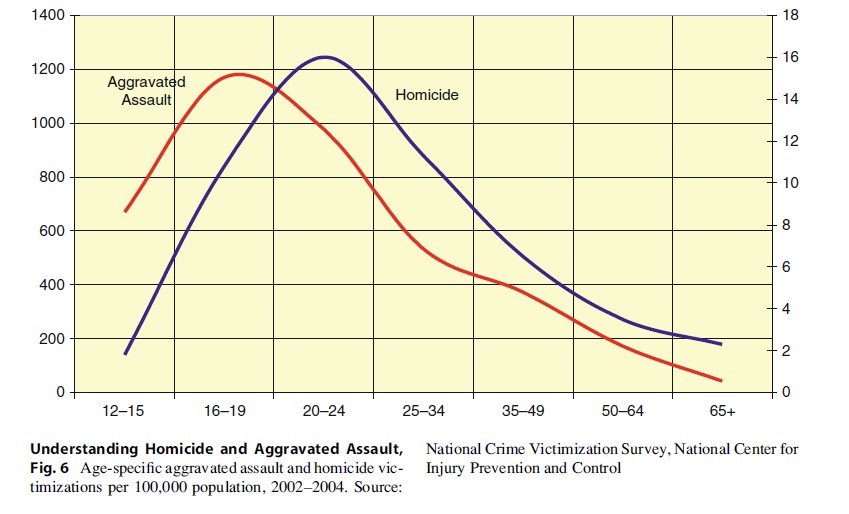
The third column in Table 1 presents the “lethality ratio,” or the number of aggravated assault victims for every homicide victim, by characteristics of the victim and whether or not the victim was attacked or threatened by an offender with a firearm.
The lethality ratio is a rough approximation of the degree to which death results from the serious violence a group experiences. A full accounting of the lethal outcomes of violent crime would have to include other “precipitating” offenses, such as robbery and rape, in addition to aggravated assault, but the group differences shown in the table would not be altered substantially.
For the population over the age of 11, the average ratio is 65 aggravated assaults for every homicide. Some groups – teenagers, whites, and women – have ratios that are much higher than average, meaning that the serious violence they experience is less likely to result in death than is true for groups with lower-than-average ratios, such as blacks and, interestingly, senior citizens. Persons age 65 and over have a lethality ratio of 19 aggravated assaults for each homicide, the lowest ratio shown. It is tempting to attribute this result to the frailty of older persons, which would transform more of their serious assaults into homicides, but their comparatively low homicide rate of 2.3 per 100,000 suggests that is not the full story. Rather, older persons are much less likely to experience interpersonal violence, serious or not, than other age groups. Even their level of simple assault (assaults without a dangerous weapon or serious injury) is far lower than that of younger persons.
But when they are attacked, they are more likely to be killed.
The group with the largest lethality ratio is near the other end of the age spectrum. Adolescents between 12 and 15 years old experience 372 aggravated assaults for each homicide. Teenagers, who are said to have replaced fists and knives with guns when they fight, remain far less likely to die in violent encounters than their parents or grandparents.
Finally, attacks involving firearms produce far more deaths per incident than those committed with a knife or club or no weapon. There is no question that firearms are lethal weapons, and many analysts argue that decreases in the availability of firearms would result in fewer homicides. But critics of this view maintain that strict controls on firearm availability would deprive victims of needed protection and even increase violent crime rates, if offenders assume their victims are unarmed. A comprehensive assessment by the National Research Council finds fault with the methods and data used in studies of the “more guns, less crime” hypothesis, regardless of their results (Wellford et al. 2004). The relationship between firearms and violence remains a contentious research and public issue in the United States, which is not surprising in a nation with persisting traditions of popular justice and self-protection, high homicide rates, and the largest private arsenal in the world.
Victim-Offender Relationship
Victims of homicide and serious assault are often acquainted with the offender, sometimes intimately. According to the NCVS, about 47 % of aggravated assault victims in 2004 knew their attacker. It is more difficult to determine the proportion of homicide victims who knew their killer, both because the victim is unable to say and because an offender is arrested in only about 6-in-10 homicides committed in the United States (Federal Bureau of Investigation 2006). The FBI’s Supplementary Homicide Reports (SHR), a detailed compilation of homicide incidents, victims, and known offenders, show that 43 % of homicide victims in 2004 were acquainted with the offender, 13 % were strangers, and the victim-offender relationship could not be determined in the remaining 44 % of cases. Women and younger victims are more likely to know their attackers than men and older victims. The same patterns emerge in violence among family members and other intimates. About 16 % of aggravated assault victims and 12 % of homicide victims in 2004 were attacked by a family member, including spouses or ex-spouses. So-called intimate partner violence has received widespread attention by researchers, victims’ advocates, and policymakers in the United States. It is worth taking a closer look at patterns in intimate violence.
Intimate Partner Violence
Two facts stand out in patterns of intimate partner violence: (1) Women are more likely than men to be victims of serious intimate partner violence. (2) Levels of intimate partner violence have declined markedly over time. Both of these patterns are revealed in Figs. 7 and 8, which show US trends in nonfatal and fatal intimate partner violence, respectively, by sex of the victim.
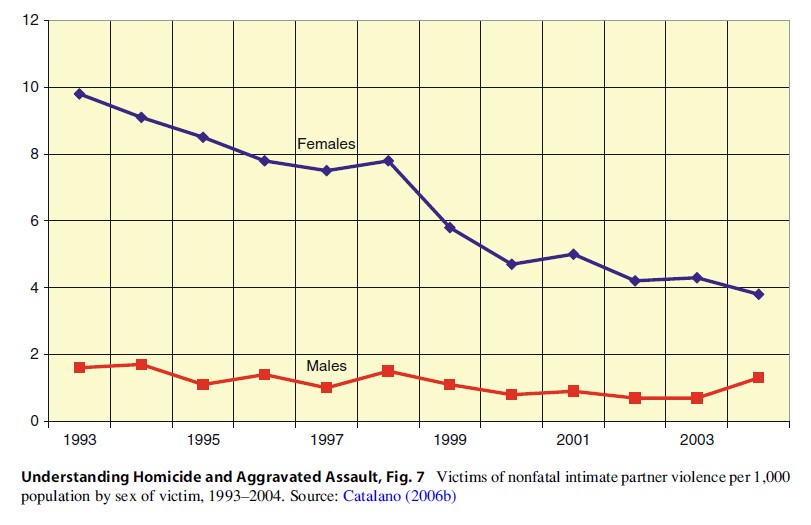
Both figures show higher levels of victimization among female than male intimate partners and decreases in victimization over time, but the rate of decline differs for men and women by type of victimization. Continuous data from the NCVS on nonfatal intimate partner violence are available only since 1993. They show a greater decline in the nonfatal victimization of women than men. By contrast, the drop in male victims of intimate homicide over the past 30 years is steeper than the drop in female victims, which only began in the early 1990s. These contrasting declines are, at first glance, puzzling. What accounts for the sex differences in nonfatal and fatal victimization trends?
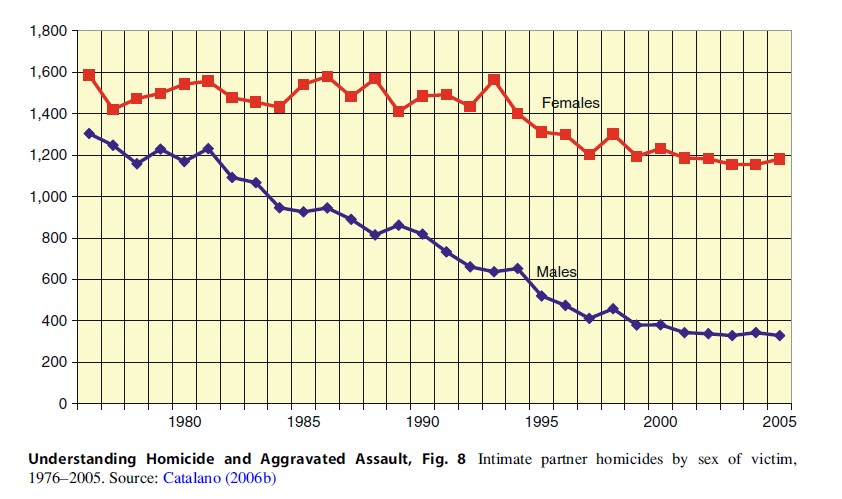
The conditions responsible for reducing violent crime generally during the 1990s – including a booming economy, more police, and a dramatic expansion in imprisonment – might be expected to have reduced violence against women (Levitt 2004; Rosenfeld 2004). But that makes the sharper drop in male than female intimate homicide victimization all the more puzzling. A key to the puzzle lies in the differing circumstances of male and female intimate partner homicide.
When women kill their male partners, the homicide is much more likely to be “victim precipitated” than when men kill their female partners (Rosenfeld 1997; Wolfgang 1975 [1958]). A homicide is victim precipitated when the victim initiates the violent conflict that ends in his or her death. The person who starts a fight is not always the one left standing when it ends. When women kill their male partners, they typically do so in response to an attack or threat. The same is not true of men who kill their intimate partners (Rosenfeld 1997). Women are more apt than men to kill as a last resort, when all else fails, to stop the violence directed at them, sometimes over a long period of time. Women, then, should be more willing than men to take advantage of nonviolent alternatives to homicide that effectively reduce their exposure to their partner’s violence.
Dugan et al. (1999) used that reasoning to explain what otherwise is a very curious result in their study of the impact of hotlines, shelters, legal advocacy, and other domestic violence services and resources on trends in intimate partner killings: intimate killings of men, not women, dropped more rapidly in cities where such resources were more prevalent. It is a fair bet that the domestic violence prevention advocates who demanded more services and greater legal protection for battered and abused women and their children did not intend that their struggle would result in saving batterers’ lives. But if we view domestic violence resources as providing nonviolent alternatives to killing a violent partner, it is not surprising in light of the sex difference in the circumstances of intimate partner homicide that they would have a greater impact on the rate at which women kill their male partners than the rate at which men kill their female partners.
In a second study, Dugan et al. (1999) found that the homicide reductions associated with domestic violence services and legal reforms were uneven across racial groups and by marital status: the availability of domestic violence resources produced greater reductions among whites and married couples than among blacks and unmarried intimate partners. These results are consistent with evaluations of so-called mandatory and pro-arrest policies for domestic violence, which have found stronger deterrence effects of arrest on subsequent violence for married and employed men than for the unmarried and unemployed (Sherman 1992). Domestic violence policy interventions explain only part of the drop in intimate partner homicide; rising divorce rates also contributed to the decline as more women exited relationships with violent or abusive partners (Dugan et al. 1999). In fact, an important rationale for liberalizing divorce laws in Europe during the nineteenth and twentieth centuries was to reduce the number of domestic homicides (Gillis 1996). The institution of divorce was the first and arguably remains the most effective program to prevent domestic violence.
Theories Of Homicide And Assault
Homicide and assault are studied from a variety of theoretical perspectives, and no single theory commands consensus among students of interpersonal violence, even when the focus is limited to criminological perspectives. It is useful to categorize theories of violence according to their level of analysis and whether they apply to all forms of violence, legal as well as criminal, or are restricted to nonnormative or criminal violence. Microlevel theories direct attention to characteristics of individuals or their immediate social context (e.g., family and peer influences) to explain individual differences in violent behavior. Macrolevel theories explain the variation in rates of violence across groups, populations, and societies. Both micro and macro criminological theories of violence are limited primarily to explaining socially disapproved violence, although two perspectives, Felson’s (2004) interactionist theory and Black’s (1998) theory of social control, encompass normative violence as well.
While conceptually and analytically distinct, specific micro and macro perspectives share underlying assumptions about the individual and social processes implicated in crime. The three major microlevel perspectives in criminology – social learning theory, social control theory, and strain theory – share behavioral assumptions with three of the major macrolevel perspectives on crime – cultural deviance theory, social disorganization theory, and anomie theory, respectively (Messner and Rosenfeld 2007). Social learning theory posits that criminal behavior is learned under the same social conditions that shape learning of all kinds. Its macrolevel counterpart, so-called cultural deviance perspectives, explains variations in violent crime across groups and communities on the basis of cultural or subcultural values, beliefs, and norms that promote or tolerate violent conduct. Social control theory explains criminal behavior as resulting from weakened or absent social bonds that, when strong, discourage crime and delinquency. Its macrolevel analogue, social disorganization theory, specifies the social conditions that weaken social bonds, including economic deprivation, residential instability, and population heterogeneity. Finally, strain theories posit that criminal behavior is a function of failure to attain desired goals, aversive stimuli, and negative emotions. At the macrolevel, anomie theories hold that high levels of crime characterize communities and societies in which cultural goals extol the virtues of economic success for everyone, access to the legitimate means to attain cultural goals are unequally distributed in the population, and the social controls and supports of basic institutions are weakened.
The three pairs of criminological theories make very different assumptions about how criminality is facilitated by personal and social characteristics. Cultural-learning theories propose that criminal propensities are generated in interaction with others whose values and beliefs conflict with prevailing legal standards. In sharp contrast, social control theories view criminal behavior as needing no special explanation; what must be explained is not why some people steal or behave violently, but why the rest of us do not. People conform to law, control theorists argue, because not doing so is costly. To the degree nonconformity threatens valued social relationships and investments in rewarding legitimate activities, people will conform. In addition, time and energy devoted to legitimate pursuits limit the time and energy available for criminal activity. Contemporary strain and anomie theories incorporate elements of social learning and control theories but also specify the personal and social processes that weaken social controls and encourage the adoption of deviant or criminal attitudes and beliefs (Messner and Rosenfeld 2007).
As mentioned, none of these perspectives holds a commanding position among criminologists. Researchers tend to mix and match arguments from multiple perspectives, often oblivious to the contrasting assumptions they make about how and why persons violate legal standards (Kornhauser 1978). In recent years, rival theories have emerged that seek to transcend the limitations of established theories or recast them around new insights. Routine activity theory (Felson 2002) downplays the significance the older perspectives attach to criminal motivations and emphasizes the opportunities to commit crime that emerge when offenders, however motivated, come into contact with victims in situations that facilitate theft or attack (e.g., an unguarded cash register, a lone individual on a darkened or empty street). Self-control theory (Gottfredson and Hirschi 1990) transcends social control theories by locating the source of deviant behavior in early childhood socialization. Poor parenting produces persons incapable of forming deep attachments to others or controlling their impulses and who will commit crimes whenever opportunity permits. Life course theories also emphasize the importance of early childhood in facilitating or retarding delinquent and criminal behavior in adolescence and adulthood but reject self-control theory’s deterministic assumption that faulty socialization spells trouble throughout the life course (Laub and Sampson 2003; Sampson and Laub 1993). Age-graded “turning points,” such as marriage, military service, or a good job can promote conformity and discourage criminality.
None of these established or emerging criminological perspectives applies specifically to criminal violence; they are intended to explain criminal behavior generally: violent offending, property offending, and public order offending, such as possessing illegal drugs. At the same time, the explanatory scope of all of them, unsurprisingly, is restricted to criminal violence. That is a significant limitation. None of the criminological theories can explain why some forms of violent conduct are socially condemned while others are not. Implicitly or by design, all take the prevailing legal order as given and therefore are fundamentally culture bound.
Not all theories of violence are so restricted in their application. Black’s (1998) theory of social control views violence as one among several means of conflict management. Whether disputants engage in violent “self-help” rather than avoidance, toleration, mediation, arbitration, or other ways of managing conflict depends on how closely they are related to one another, the degree of economic inequality or cultural difference between them and relevant third parties, and their integration into broader collectivities. Black’s theory is intended to explain dispute-related violence of all kinds, at all times, everywhere.
Felson’s (2004) interactionist theory explains both dispute-related and predatory violence. Whereas persons engage in dispute-related (sometimes termed “moralistic”) violence in response to a perceived wrong, predatory violence is committed without real or imagined provocation by the victim. When a parent spanks a child for misbehaving, she is engaging in moralistic violence. When a robber demands his victim’s money at gunpoint, he is engaging in predatory violence. Rejecting the traditional duality of “expressive” versus “instrumental” violence, Felson argues that all violence is intended to achieve some goal, whether to exact compliance, achieve justice, or secure a desired social identity. His theory applies to both criminal and noncriminal violence, in any and all societies and historical periods.
Many forms of violence are roundly condemned and, in principle, can be explained with reference to the various problems and pathologies highlighted in traditional criminological perspectives. But the commonalities underlying normative and nonnormative violence are obscured by such a restrictive focus on the problematic origins and manifestations of violence. Science craves generality (Black 1995). All else equal, theories of violence capable of explaining the executioner’s behavior, and not merely that of the condemned, are better.
Violence Reduction And Mass Incarceration
Homicide and aggravated assault rates in the United States have declined markedly over the past two decades. Homicide fell by 43 % between 1991 and 2005. UCR aggravated assault rates dropped by 33 % over the same period. As measured in the NCVS, aggravated assault rates fell by 57 %. Declines of this magnitude in death and serious injury must be counted as good news. But valued effects are not always brought about by equally appealing causes. That is the case with the relationship between recent crime reductions and mass imprisonment in the United States.
Over a quarter of a century ago, the United States embarked on an unparalleled program of prison expansion. For most of the twentieth century, US imprisonment rates were on par with those prevailing in Europe and the rest of the developed world. Since the mid-1970s, the US imprisonment rate has risen fivefold. No other nation incarcerates its citizens at the now customary levels in the United States.
The rise of mass incarceration in the United States resulted from deliberate policy choices and was not the unavoidable outcome of increasing crime rates. One state after another, with strong inducements and pressures from the federal government, instituted mandatory-minimum sentences, sentence enhancements, and truth-in-sentencing provisions to insure that more convicted felons would be sent to prison and would serve longer sentences (Messner and Rosenfeld 2007, pp. 115–118). Drug offenders were a prime target of the sentencing reforms. Presumably African-Americans were not, but changes in drug laws and other get-tough policies, whether intended or not, have disproportionately affected the life chances of AfricanAmericans (Tonry 1996). Fully 10 % of African-American men between the ages of 25 and 29 resided in a state or federal prison in 2002, compared to 2 % of Hispanic men and 1 % of white men of the same age (Messner and Rosenfeld 2007, p. 5). It is fair to assume that few policymakers intended or foresaw a quintupling of the prison population as a consequence of the mandatory-minimum sentencing and truth-in-sentencing laws passed over the last 30 years, but once the dramatic escalation in incarceration – and its racially disparate effects – became evident, if policymakers were inclined to limit future imprisonment growth, presumably they would have done so by now (Tonry 1996).
Although debate remains about the size and even the direction of the effect, accumulating research evidence shows that the massive expansion in imprisonment has reduced crime rates in the United States (Levitt 1996, 2002, 2004; Marvell and Moody 1994; but see DeFina and Arvanites 2002, Tonry 2004). It would be astounding if mass imprisonment at the level used in the United States had no impact on crime rates. But the effects are complex. They are likely to differ by age, with the strongest crime-reduction effects among offenders in their early 30s, who have the longest residual criminal careers, and the weakest effects among juveniles, who are at low risk for incarceration in state and federal prisons. And recent research has shown that the crime-reduction effects of incarceration diminish with increases in the scale of imprisonment (Liedka et al. 2006).
Mass imprisonment is a stopgap and costly crime-control policy. Most persons released from prison are rearrested for new crimes and half return to prison within 3 years (Langan and Levin 2002). The costs of the huge correctional complex are borne primarily by state and local governments, and they have risen at roughly double the rate of state and local outlays for education, health care, and policing over the past 30 years (Hughes 2006). Each additional dollar spent on prisons, jails, and community corrections is money that states and local areas cannot devote to other pressing needs, including improvements in education and early childhood interventions that hold some promise for reducing criminality and not just containing crime rates by incapacitating offenders (Greenwood et al. 1998).
Add to the economic costs of mass imprisonment the political and social costs in the form of a growing disenfranchised population of ex-prisoners, further destabilization of the communities hardest hit by the continuous “churning” of young men moving in and out of prison, the high recidivism rates of ex-prisoners, and the racially disparate impact of prison expansion – and policy alternatives that promise to limit both crime rates and prison expansion begin to have growing appeal to policymakers at all levels of government, regardless of political affiliation. A “prisoner reentry” movement has attracted the attention of the federal government and state legislatures across the country. Advocates of prisoner reentry point to the limited employment, housing, health, and social services available to persons returning home from prison and the spotty and inconsistent supervision of many ex-prisoners in the community as primary reasons for their high recidivism rates (see Petersilia 2003; Travis 2005). To protect the communities to which they are released and staunch the flow of offenders back to prison, reentry advocates call for sharply lower parole caseloads and enhanced supportive services for ex-prisoners and their families.
Whether current reentry programs reduce recidivism rates remains uncertain, but if they are found to be effective and are widely implemented, they could well limit the overall growth in imprisonment, for the simple reason that most persons entering prison in recent years have been there at least once before (Blumstein and Beck 2005). The essential challenge to prisoner reentry programs is finding the right mix of incentives, supports, and controls that will reduce the chances that persons who have already been in and out of prison, and then are reincarcerated, will not return to prison yet again when they are released.
Effective crime-control policy requires more than addressing the needs of released prisoners. The best policy is multifaceted and also should include promising approaches to the prevention and policing of violent crime and in-prison rehabilitation programs of proven effectiveness. There is no shortage of such initiatives (http://www.crimesolutions.gov/about_ojp. aspx), but combining them in a coherent policy set and providing the resources necessary to bring them to scale poses enormous political challenges.
One is tempted to say the challenge is insurmountable, but recent history indicates it is not. The United States showed the world it is possible to effect startling changes in crime-control policy when the necessary sense of urgency and political will are mobilized for action. In a nation renowned for its political decentralization and fragmentation, a coherent and self-reinforcing policy of mass imprisonment took hold almost instantaneously across the 50 states with the federal government, no matter which party was in power, leading the way. Limiting the costs of mass imprisonment and instituting effective alternatives are no less possible. The challenge is to mobilize the necessary political resources and instruments before crime rates begin to rise again.
Bibliography:
- Beeghley L (2003) Homicide: a sociological explanation. Roman & Littlefield, Lanhan
- Black D (1995) The epistemology of pure sociology. Law Soc Inquiry 20:829–870
- Black D (1998) The social structure of right and wrong, Revisedth edn. Academic, San Diego
- Blumstein A, Beck AJ (2005) Reentry as a transient state between liberty and recommitment. In: Travis J, Visher C (eds) Prisoner reentry and crime in America. Cambridge University Press, New York
- Catalano SM (2006a) Criminal victimization, 2005. US Department of Justice, Washington, DC
- Catalano SM (2006b) Intimate partner violence in the United States. US Department of Justice, Washington, DC, http://www.ojp.usdoj.gov/bjs/intimate/ipv.htm
- Crowell NA, Burgess AW (eds) (1996) Understanding violence against women. National Academy Press, Washington, DC
- DeFina RH, Arvanites TM (2002) The weak effect of imprisonment on crime: 1971–1992. Soc Sci Quart 83:635–653
- Dugan L, Nagin D, Rosenfeld R (1999) Explaining the decline in intimate partner homicide: the effects of changing domesticity, Women’s status, and domestic violence resources. Homicide Stud 3:187–214
- Dugan L, Nagin D, Rosenfeld R (2003) Exposure reduction or retaliation? the effects of domestic violence resources on intimate partner homicide. Law Soc Rev 37:169–198
- Federal Bureau of Investigation (2006) Crime in the United States 2005. US Department of Justice, Washington, DC, http://www.fbi.gov/ucr/05cius/
- Felson MK (2002) Crime and everyday life, 3rd edn. Sage, Thousand Oaks
- Felson RB (2004) Predatory and dispute-related violence: a social interactionist approach in routine activity and rational choice. Adv Criminol Theory 5:103–125
- Gillis AR (1996) So long as they both shall live: marital dissolution and the decline of domestic homicide in France, 1852–1909. Am J Sociol 101: 1273–1305
- Gottfredson M, Hirschi T (1990) A general theory of crime. Stanford University Press, Stanford
- Greenwood PW, Karyn Model C, Rydell P, Chiesa J (1998) Diverting children from a life of crime. RAND Corporation, Santa Monica
- Hughes KA (2006) Justice expenditure and employment in the united states, 2003. U.S. Department of Justice, Washington, DC
- Kleck G, McElrath K (1991) The effects of weaponry on human violence. Soc Forces 69:669–692
- Kornhauser RR (1978) Social sources of delinquency: an appraisal of analytic models. University of Chicago Press, Chicago
- Langan PA, Levin DJ (2002) Recidivism of prisoners released in 1994. U.S. Department of Justice, Washington, DC
- Laub JH, Sampson RJ (2003) Shared beginnings, divergent lives: delinquent boys to Age 70. Harvard University Press, Cambridge
- Levitt SD (1996) The effect of prison population size on crime rates: evidence from prison overcrowding litigation. Quart J Economics 111:319–352
- Levitt SD (2002) Deterrence. In: Wilson JQ, Petersilia J (eds) Crime: public policies for crime control. ICS Press, Oakland
- Levitt SD (2004) Understanding why crime fell in the 1990s: four factors that explain the decline and six that do not. J Econ Perspect 18:163–190
- Liedka RV, Piehl AM, Useem B (2006) The crime-control effect of incarceration: does scale matter? Criminol Public Policy 5:245–276
- Marvell TB, Moody CE (1994) Prison population and crime reduction. J Quant Criminol 10:109–139
- Messner SF, Rosenfeld R (2007) Crime and the American dream, 4th edn. Wadsworth, Belmont
- Petersilia J (2003) When prisoners come home: parole and prisoner reentry. Oxford University Press, New York
- Reiss AJ Jr, Roth JA (eds) (1993) Understanding and preventing violence. National Academy Press, Washington, DC
- Rosenfeld R (1997) Changing relationships between men and women: a note on the decline in intimate partner homicide. Homicide Stud 1:72–83
- Rosenfeld R (2004) The case of the unsolved crime decline. Sci Am 290:68–77
- Rosenfeld R (2007) Explaining the divergence between UCR and NCVS aggravated assault trends. In: Lynch JP, Addington LA (eds) Understanding crime statistics: revisiting the divergence of the NCVS and the UCR. Cambridge University Press, New York, pp 251–268
- Russell DEH (1990) Rape in marriage. Indiana University Press, Bloomington
- Sampson RJ, Laub JH (1993) Crime in the making: pathways and turning points through life. Harvard University Press, Cambridge
- Sherman LW (1992) Policing domestic violence: experiments and dilemmas. Free Press, New York
- Tonry M (1996) Malign neglect: race, crime, and punishment in America. Oxford University Press, New York
- Tonry M (2004) Thinking about crime: sense and sensibility in American penal culture. Oxford University Press, New York
- Travis J (2005) But they all come back: facing the challenges of prisoner reentry. Urban Institute Press, Washington, DC
- Wellford CF, Pepper JV, Petrie CV (eds) (2004) Firearms and violence: a critical review. National Academies Press, Washington, DC
- Wolfgang ME (1975/1958) Patterns in criminal homicide. Patterson Smith, Montclair
- Zimring FE (2007) The great American crime decline. Oxford University Press, New York
- Zimring FE, Hawkins G (1997) Crime is not the problem: lethal violence in America. Oxford University Press, New York
See also:
Free research papers are not written to satisfy your specific instructions. You can use our professional writing services to buy a custom research paper on any topic and get your high quality paper at affordable price.





